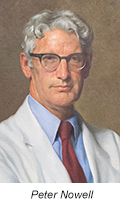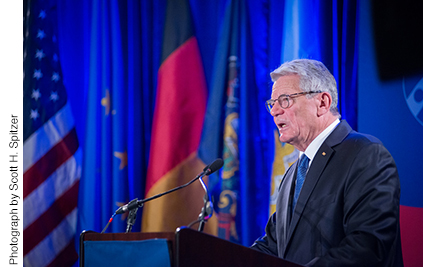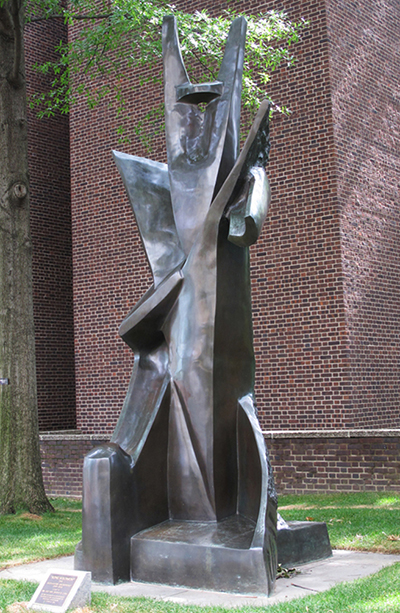Honoring Peter C. Nowell and the Inaugural Peter C. Nowell, MD, Professor Kojo S. Elenitoba-Johnson

In a long-anticipated honor for Peter C. Nowell, the Lasker Award-winning Penn luminary who co-discovered the Philadelphia chromosome, an endowed professorship has been established in his name. The reception to recognize Dr. Nowell’s career accomplishments and to welcome the inaugural Peter C. Nowell, MD, Professor, Kojo S. Elenitoba-Johnson, will be held at 6 p.m. on October 20 in the Henry A. Jordan, M’62 Medical Education Center.
Dr. Nowell, the Gaylord P. and Mary Louise Harnwell Emeritus Professor of Pathology and Laboratory Medicine at the Perelman School of Medicine, along with his research partner, the late David Hungerford, discovered the Philadelphia chromosome in 1960. This finding, an abnormally small chromosome in the cancerous white blood cells of patients with chronic myeloid leukemia (CML), was considered a watershed moment in cancer research, demonstrating the genetic basis for cancer, which ran counter to the prevailing thought at the time.
Their revolutionary work also formed the foundation for the clinical trials for Gleevec®, the Novartis Pharmaceuticals drug that received FDA approval in 2001 and has since stabilized disease in 95% of treated CML patients, and been approved to treat 10 different kinds of cancer. In 1988, Dr. Nowell shared the Albert Lasker Clinical Medical Research Award, the nation’s highest honor for biomedical research, with the University of Pennsylvania’s Alfred G. Knudson, Jr. (Almanac September 22, 1998).
The chair was made possible through a collaborative effort by faculty, some of whom trained with Dr. Nowell, and myriad donors coming together from a broad swath of the Penn community. Many donors are, in fact, long-time supporters of the Abramson Cancer Center, for which Dr. Nowell served as the first director beginning in 1973.
“I am deeply gratified that such stalwart supporters in our fight against cancer have chosen to honor the groundbreaking work that Dr. Nowell has contributed to oncology, innovations that shifted the cancer paradigm decades ago and that reverberate now in cancer immunotherapy,” says Chi Van Dang, the John H. Glick, MD, Abramson Cancer Center Director’s Professor and Director of the Abramson Cancer Center. “A professorship honoring Peter Nowell is one of many deserved plaudits for a genuine giant in Penn history and cancer discovery.”

The designated chairholder, Dr. Elenitoba-Johnson, who joined Penn in July, is an international leader in the field of hematopathology, molecular pathology and mass spectrometry-driven proteomics. He is also the founding director of Penn Medicine’s Center for Personalized Diagnostics and chief of the Division of Molecular and Genomic Pathology. His former laboratory at the University of Michigan is credited with having identified several recurrent genetic abnormalities linked to the development and progression of a number of lymphoma subtypes.
“Dr. Elenitoba-Johnson is an inspired and ideal choice as the inaugural Peter. C. Nowell, MD, Professor,” said J. Larry Jameson, executive vice president for the Health System and dean of the Perelman School of Medicine. “He is an outstanding investigator whose research has already had significant impact, and I am excited by the prospect of future innovations, as transformative as Dr. Nowell’s, arising from his work.”
Dr. Elenitoba-Johnson earned his MD from the College of Medicine, University of Lagos, in Lagos, Nigeria. Subsequently, he went to the Brown University School of Medicine for his residency in anatomic and clinical pathology, and served as chief resident. He then moved on to the National Cancer Institute to complete a fellowship in hematopathology, as well as the Leadership Development for Physicians in Academic Health Centers program at the Harvard School of Public Health. Before arriving at Penn, he held the Henry C. Bryant Professorship at the University of Michigan and served as director of the Molecular Diagnostics Laboratory there.
Hosting German President Joachim Gauck
University of Pennsylvania President Amy Gutmann and Penn’s Perry World House hosted Joachim Gauck, president of the Federal Republic of Germany, for a public lecture on shared US-German values. His lecture, Freedom—our shared bond, given on October 6, discussed many collaborations between the two countries since the mid-18th century, when Penn began this country’s oldest German studies program in 1754, with the first professor of German hired in 1757. Benjamin Franklin traveled to Germany in 1766.
Dr. Gutmann introduced President Gauck: “We are deeply honored to have President Gauck visit our campus. He is a highly respected advocate of freedom and democratic principles, and brings a unique perspective to his talk given the current political challenges unfolding in Europe. I know his insights will be a source of inspiration to our students, faculty and staff.”
President Gauck was elected by the Federal Convention on March 18, 2012, at which time he became the 11th president of the Federal Republic of Germany. He gained prominence in German politics for his involvement in the opposition in the German Democratic Republic (GDR) and the quest for freedom, democracy and human rights. A pastor for many years, he was one of the initiators of the church and popular resistance to the communist regime in the GDR, leading weekly prayers for peace that led to protest demonstrations.
President Gauck’s visit to the United States came days after German Unity Day on October 3, a day marking the anniversary of German reunification in 1990. As a champion of freedom, he had helped usher in democracy 25 years ago.
Report of the Committee on Manufacturer Responsibility
The following report for the 2014-2015 academic year was sent to Vice President and University Secretary Leslie Kruhly from Mark Stern, chair of the Committee on Manufacturer Responsibility (CMR), in accordance with the Code of Workplace Conduct. As outlined in the Code, the CMR will review the Code annually, as well as the effectiveness of monitoring, the state of compliance of the apparel licensees and any alleged violations of the Code.
The revised Code of Workplace Conduct for Penn Licensed Product Manufacturers is published For Comment on the following pages.
Report of the Committee on Manufacturer Responsibility June 2015
It is my pleasure to report on the deliberations of the Committee of Manufacturer Responsibility during the 2014-2015 academic year. In accordance with the Code of Workplace Conduct for Penn Licensed Product Manufacturers, the Committee met for four regular meetings during the academic year. A fifth meeting was held to review proposed revisions to the Code. In addition to monitoring code compliance, the Committee’s work this year included revising the Code to update the Code, correct certain errors and clarify its procedures.
Code Compliance
As of June 2015, 147 out of 153 licensees were reviewed and found to be in compliance with the Code. Six previous licensees did not respond to our questionnaire, and as a consequence, were not renewed for 2015-2016.
Revisions to the Code
Sean Burke, the representative of the Office of the General Counsel to the Committee, led the Committee’s efforts to revise the Code.
The Committee determined that changes to the Code were necessary to ensure that its language is clearly worded, reflects the University’s goals and is consistent with Penn’s compliance oversight procedures. This past year, the Committee focused on ensuring that the language and concepts were clearly articulated throughout the document principally to facilitate the ability to enforce the regulations.
Several changes streamlined the Code’s organization (for example, moving the section on overtime to the section on hours of work).
Substantive changes to the Code included adding language requiring manufacturers’ work environments to be free from recognized hazards. Other changes, pertaining to remediation procedures, emphasized the University’s right to terminate an agreement with a licensee if the licensee failed to correct a violation.
The Committee scheduled a special meeting on April 30, and voted unanimously to recommend these revisions. I am attaching a copy of our recommended revised Code.
On behalf of the Committee, I want to express my appreciation to Jacqueline Miraglia (Penn Center for Innovation) for her able staffing of the Committee and for overseeing the licensee compliance process.
It has been a privilege to serve as chair of the Committee during the past year. I will be on leave during fall 2015. In my absence, Steven Kimbrough of the Wharton School has agreed to serve as acting chair.
—Mark J. Stern, Chair
Kenneth L.M. Pray Chair, School of Social Policy & Practice
Members of the Committee on Manufacturer Responsibility 2014-2015
Mark Stern (Chair), Social Policy & Practice
Steven Kimbrough, Wharton
Jon Shaw, PPSA
Yessenia Gutierrez, Civic House Associates Coalition
Amit Pujari, Civic House Associates Coalition
Aidan McConnell, Undergraduate Assembly
Gabrielle Nagler, GAPSA
Ex-Officio members
Jessie Burns, Provost’s Office
Leah Popowich, President’s Office
Christopher Bradie, Business Services
Sean Burke, Office of the General Counsel
Leslie Mellet, Office of the Secretary
Response
Thank you for forwarding your report on the work of the Committee on Manufacturer Responsibility in 2014-2015. I commend you and the Committee for your deliberations over this past year, particularly your thorough review of the Code and careful work in ensuring its alignment with the University’s goals.
Please accept my thanks for your significant contributions of time and talent during this past year as chair of the Committee. I look forward to your continued leadership upon your return from sabbatical in January. The Committee is in good hands with Steve Kimbrough as acting chair this semester.
—Leslie Kruhly, Vice President and University Secretary
2015 National Drug-Free Work Week: October 12-17
Because the University of Pennsylvania values the health and safety of the entire community, Penn is committed to maintaining a drug-free workplace year-round. Drug and alcohol abuse can harm not only the person using these substances, but also his or her family, friends and coworkers. During National Drug-Free Work Week, from October 12-17, please take the time to review the University’s drug and alcohol policies.
Penn’s Drug and Alcohol Policies
Penn prohibits the unlawful manufacture, distribution, dispensation, sale, possession or use of any drug by its employees in the workplace. Complete policy details are available online:
Drug-Free Workplace Policy:
http://www.hr.upenn.edu/myhr/resources/policy/performance/drugfreeworkplace
The University Alcohol and Drug Policy:
http://www.vpul.upenn.edu/alcohol/policy2.php
Understanding Addiction
Addiction is a serious disease, but many effective treatments are available. Visit the Penn Behavioral Health website at http://www.pennbehavioralhealth.org/resources-addictions.aspx for facts and information about addiction, recovery and support services.
Help is Here
If you or a family member has a substance abuse problem, we encourage you to seek help. Penn provides free, confidential counseling services for you and your immediate family members through the Employee Assistance Program (EAP). The EAP will assist you with challenges that may interfere with your personal or professional life, including substance abuse.
For more information about the EAP’s counseling and referral services, visit the Employee Assistance Program web page at https://www.hr.upenn.edu/myhr/worklife/healthy/eap or contact the Employee Assistance Program 24 hours a day, 7 days a week at (888) 321-4433.
Models of Excellence Award Nominations Due by October 29
If you want to recognize the exemplary work of a staff member or team by nominating them for a 2016 Models of Excellence award, you must act soon. Nominations for the 2016 Models of Excellence awards are due by Thursday, October 29. Visit https://www.hr.upenn.edu/models for the online nomination form and details about the nomination process.
The Models of Excellence award program celebrates the extraordinary achievements of full- and part-time staff members from across the University’s schools and centers. Awards are given in three categories:
• Models of Excellence Award—Recognizes staff member accomplishments that reflect initiative, leadership, increased efficiency and a deep commitment to service.
• Model Supervisor Award—Honors supervisors who contribute to Penn’s success.
• Pillars of Excellence Award—Celebrates the important work that weekly-paid staff members do to promote Penn’s success.
All nominees receive a certificate of appreciation for their service. Models of Excellence, Pillars of Excellence and Model Supervisor winners each receive $500 and a symbolic award. Nominees selected for honorable mention receive $250 and a symbolic award. Awards will be presented at the Models of Excellence ceremony on March 30, 2016 in Irvine Auditorium.
Visit https://www.hr.upenn.edu/models for more information about the Models of Excellence program, or contact Human Resources at models@hr.upenn.edu or (215) 898-1012 if you have questions.
—Division of Human Resources




 Carolyn Hoff Lynch, CW’68, the philanthropist and former Penn Trustee for whom the Carolyn Lynch Laboratory was named, died of complications from acute myeloid leukemia on October 1. She was 69 years old.
Carolyn Hoff Lynch, CW’68, the philanthropist and former Penn Trustee for whom the Carolyn Lynch Laboratory was named, died of complications from acute myeloid leukemia on October 1. She was 69 years old. This year, Penn Museum is one of more than 100 collaborating organizations from across the United States and Canada participating in International Archaeology Day with special activities to raise public awareness of archaeology locally and nationally. Penn Museum will offer behind-the-scenes lab tours, talks on current research and mummification workshops. The special day also includes archaeological site simulations, a 3-D printing demonstration and Q&A sessions with researchers and conservators on Saturday, October 17, from 11 a.m.-4 p.m. The family-friendly program, So You Wanna Be an Archaeologist?, highlights the training and technology used by archaeologists, presented against a backdrop of mummies, ancient skeletons, clay tablets and other artifacts from the museum’s collection.
This year, Penn Museum is one of more than 100 collaborating organizations from across the United States and Canada participating in International Archaeology Day with special activities to raise public awareness of archaeology locally and nationally. Penn Museum will offer behind-the-scenes lab tours, talks on current research and mummification workshops. The special day also includes archaeological site simulations, a 3-D printing demonstration and Q&A sessions with researchers and conservators on Saturday, October 17, from 11 a.m.-4 p.m. The family-friendly program, So You Wanna Be an Archaeologist?, highlights the training and technology used by archaeologists, presented against a backdrop of mummies, ancient skeletons, clay tablets and other artifacts from the museum’s collection.
 MathThematic: a fine art exhibition features 16 artists of all media demonstrating mathematic evidence in art, whether the works are directly inspired by math (geometry, fractals, patterns, etc.) or if the mathematical principles emerge naturally and reveal themselves from our human predisposition towards order. Ruche 0352.32 by Karen Freedman is on view.
MathThematic: a fine art exhibition features 16 artists of all media demonstrating mathematic evidence in art, whether the works are directly inspired by math (geometry, fractals, patterns, etc.) or if the mathematical principles emerge naturally and reveal themselves from our human predisposition towards order. Ruche 0352.32 by Karen Freedman is on view. King Solomon, the 14.5-foot bronze statue by Alexander Archipenko, first came to Penn’s campus in 1985 on extended loan from Jeffrey H. and Sivia Loria. They formally donated the statue to Penn in honor of Judith Rodin’s inauguration as Penn president in 1994. It is located on 36th Street across from the Annenberg Public Policy Center, which was the site—from 1948-2003—of the old Penn Hillel building. This location gave the sculpture of the biblical king extra site-specific significance.
King Solomon, the 14.5-foot bronze statue by Alexander Archipenko, first came to Penn’s campus in 1985 on extended loan from Jeffrey H. and Sivia Loria. They formally donated the statue to Penn in honor of Judith Rodin’s inauguration as Penn president in 1994. It is located on 36th Street across from the Annenberg Public Policy Center, which was the site—from 1948-2003—of the old Penn Hillel building. This location gave the sculpture of the biblical king extra site-specific significance.